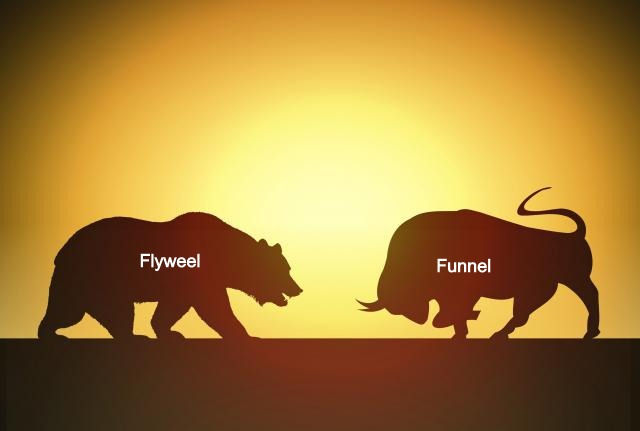The external sales channel emerges as a pivotal mechanism for extending your market reach,...
Funnel vs Flywheel

Funnel vs Flywheel: Unveiling the Dynamics of Conversion
Imagine tracking the journey of your leads and analyzing the intricate steps of their conversion. Indeed, there are different perspectives through which we can dissect and understand this vital process of conversion.
Today, let me walk you through the two most prominent paradigms that have shaped the conversation around the conversion process: the traditional funnel model and the innovative flywheel model.
Let's embark on the journey by exploring the traditional funnel model, a representation of the consumer's online journey where the conversion of leads is envisioned as a linear process. The funnel model emphasizes the need to channel consistent energy, akin to pouring water into a funnel, to invite traffic and entice potential customers to take that all-important first call to action. However, it's essential to remember that this flow is time-bound.
Understanding your buyer's decision cycle is paramount in effectively navigating the funnel model. Knowing how to engage your customers at each stage becomes the key to maintaining the momentum.
Picture the process as a continuous flow of water through the funnel. As long as you keep the flow steady by feeding your audience with timely and engaging updates, the journey continues. Yet, the moment you pause, the flow diminishes gradually, eventually coming to a standstill with the last drop.
Consider the case of an influencer who adhered to the funnel model. To sustain and grow his audience, he pushed the boundaries, consistently churning out content, and sharing compelling stories to captivate and attract new subscribers. However, an unforeseen event such as an illness or any disruption in the content creation process led to a noticeable decline in views and subscribers. This pivotal moment underscores the limitations of the funnel model and the need for a contingency plan, highlighting the significance of adaptability and effective problem-solving skills.
Now, let's delve into the alternative, the flywheel model, which revolutionizes the conventional understanding of the conversion process. The flywheel operates on the premise of leveraging customer delight and satisfaction as the propeller of growth. Unlike the funnel, the flywheel concept envisions customers as the driving force, emphasizing the need to focus on delivering exceptional experiences that build lasting relationships and foster loyalty.
The flywheel model perpetuates a continuous cycle of engagement and empowerment, where the positive energy generated by satisfied customers fuels the growth and momentum of your business. As more customers become your brand advocates, the flywheel gains momentum, resulting in a self-sustaining engine of growth and success.
To achieve a perfect balance between the two models, it is essential to infuse the dynamism of the flywheel with the structured approach of the funnel. Integrating customer satisfaction, nurturing relationships, and building a responsive and adaptable strategy will lead to a comprehensive understanding of the conversion process.
In conclusion, both the funnel and the flywheel models have their merits and limitations. Embracing the best aspects of each and adapting them to your specific business needs will enable you to carve a path toward sustainable growth and enduring success. Are you ready to fuel your journey with the perfect blend of the funnel's energy and the flywheel's momentum?"

.png?height=200&name=Crawling%20(9).png)

